Comprehensive Evaluation of the Effects of Hot Air Drying Temperature on the Chemical Composition, Flavor Characteristics and Biological Activity of Houttuynia cordata Thunb.
Abstract
1. Introduction
2. Materials and Methods
2.1. Materials
2.2. Assessment of the Drying Kinetics of HCT
2.2.1. Determination of Moisture Content
2.2.2. Drying Rate
2.2.3. Mathematical Modeling of Thin-Layer Drying Dynamics
2.2.4. Effective Diffusivity and Activation Energy
2.3. Microstructure Analysis of Dried Houttuynia cordata Thunb.
2.4. Preparation of HCT Extracts
2.5. LC-MS Analysis of Extracts from Dried HCT
2.5.1. UPLC-LTQ-Orbitrap-MS/MS (Thermo Fisher Scientific, Waltham, MA, USA) Was Employed for Systematic Identification of Chemical Components
2.5.2. Quantitative LC-MS Analysis
2.6. Determination of Bioactive Content and Antioxidant Capacity
2.6.1. Quantification of Total Phenolic Content and Total Flavonoid Content
2.6.2. Ferric Reducing Antioxidant Power (FRAP) and 1,1-Diphenyl-2-picrylhydrazyl (DPPH) Free Radical Scavenging Ability Measurement
2.7. Electronic Nose and Tongue-Based Sensory Evaluation of Dried HCT
2.7.1. Taste Profile Characterization by Insent SA402B Electronic Tongue
2.7.2. Flavor Profiling by Electronic Nose Technology
2.8. Antioxidant Activity Evaluation in HCT Treated HepG2 Cells
2.8.1. Cell Culture
2.8.2. Experimental Groups and Treatments
2.8.3. Cytotoxicity and Antioxidant Assays
2.9. Animal Experimental Design for Metabolic Study and Pharmacokinetic Experiments
3. Results
3.1. Drying Kinetics of Houttuynia cordata Thunb.
3.1.1. Drying Characteristics of Houttuynia cordata Thunb.
3.1.2. Fitting and Verification of Thin-Layer Drying Model
3.2. Impact of Thin-Layer Hot Air Drying on the Textural Characteristics of Houttuynia cordata Thunb.
3.3. The Influence of Different Hot Air Drying Temperatures on the Chemical Composition and Antioxidant Activity of Houttuynia cordata Thunb.
3.3.1. The Material Changes of Houttuynia cordata Thunb. After Drying with Hot Air at Different Temperatures
3.3.2. Thermal Effects on Phenolic Content, Flavonoid Profile, and Antioxidant Capacity in Processed Houttuynia cordata Thunb.
3.4. The Effect of Various Hot-Air Drying Temperatures on the Flavor Profile of Houttuynia cordata Thunb.
3.4.1. Flavor Profile Characterization of Processed HCT Using Electronic Tongue Analysis
3.4.2. Volatile Profile and Flavor Characteristics of HCT Under Different Drying Conditions
3.5. Evaluation of C Extract Against H2O2-Induced Oxidative Damage in HepG2 Cells
3.5.1. Cytotoxicity Assessment
3.5.2. Antioxidant Activities of HCT
3.6. Metabolic Profiling of Houttuynia cordata Thunb. in SD Rat Serum
3.6.1. The Metabolic Fate of HCT in the Rat Plasma
3.6.2. Metabolic Kinetics of Rutin, Quercetin, Chlorogenic Acid and Scutellarin in Houttuynia cordata Thunb.
4. Discussion
5. Conclusions
Supplementary Materials
Author Contributions
Funding
Institutional Review Board Statement
Informed Consent Statement
Data Availability Statement
Conflicts of Interest
Appendix A
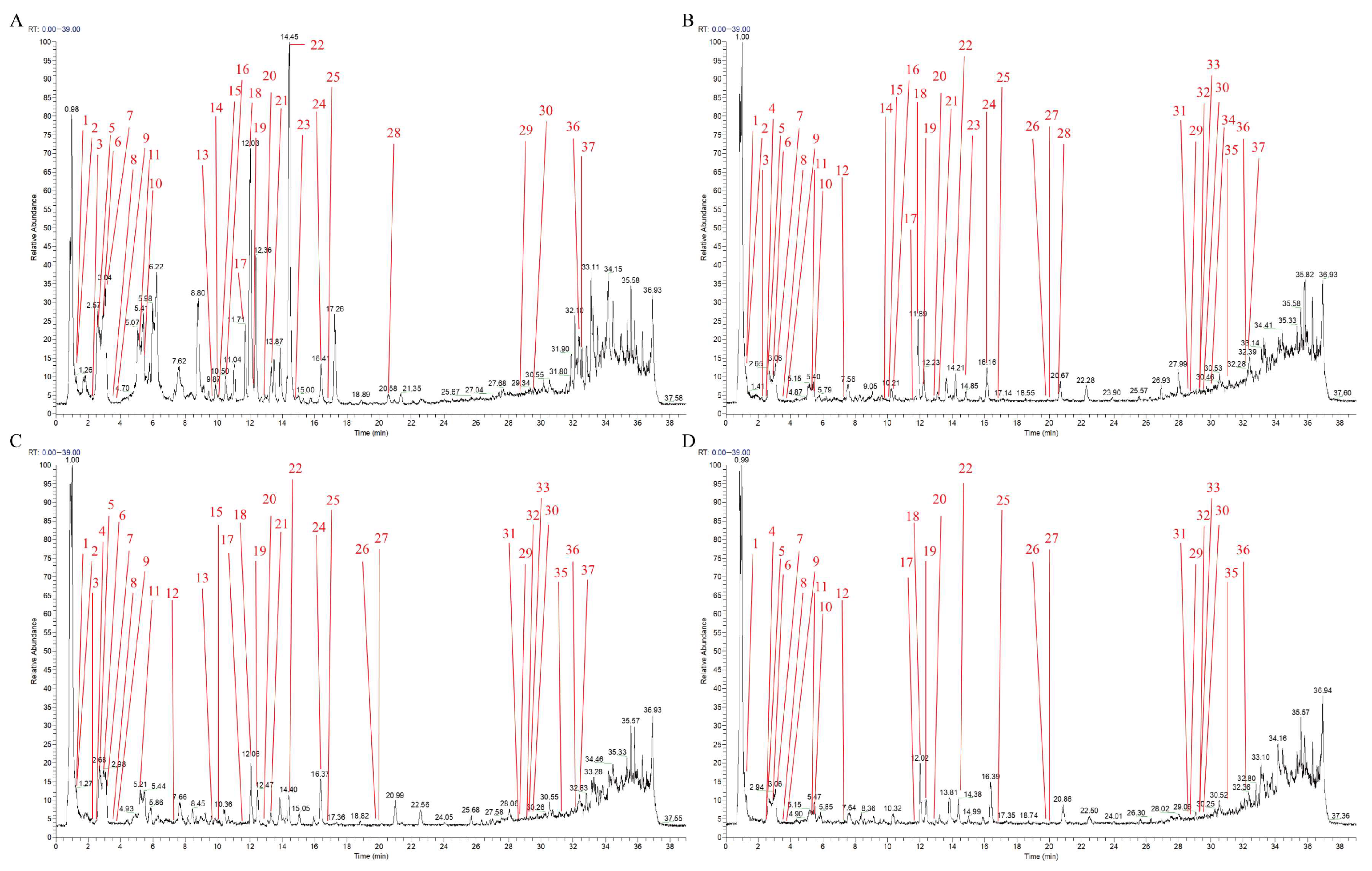
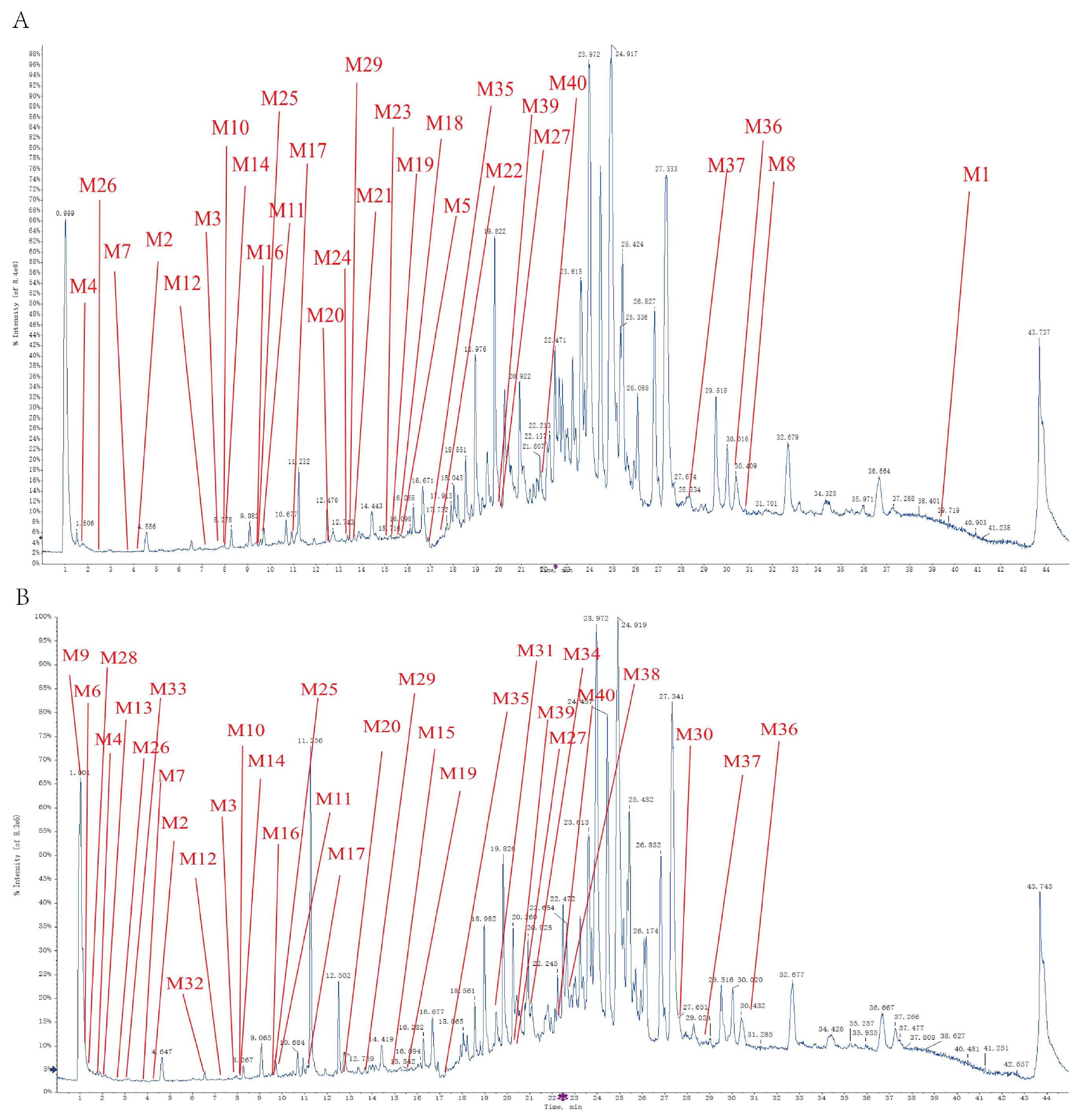
References
- Li, D.-L.; Zheng, X.-L.; Duan, L.; Deng, S.-W.; Ye, W.; Wang, A.-H.; Xing, F.-W. Ethnobotanical survey of herbal tea plants from the traditional markets in Chaoshan, China. J. Ethnopharmacol. 2017, 205, 195–206. [Google Scholar] [CrossRef] [PubMed]
- Xie, J.; Liu, F.; Jia, X.; Zhao, Y.; Liu, X.; Luo, M.; He, Y.; Liu, S.; Wu, F. Ethnobotanical study of the wild edible and healthy functional plant resources of the Gelao people in northern Guizhou, China. J. Ethnobiol. Ethnomed. 2022, 18, 72. [Google Scholar] [CrossRef] [PubMed]
- Ravindran, P.N.; Pillai, G.S.; Divakaran, M. Other herbs and spices: Mango ginger to wasabi. In Handbook of Herbs and Spices, 2nd ed.; Peter, K.V., Ed.; Woodhead Publishing: Cambridge, UK, 2012; pp. 557–582. [Google Scholar]
- Kwak, H.-J.; Jang, J.-S.; Kim, S.-M. Quality Characteristics of Kimchi with Added Houttuynia cordata. Korean J. Food Nutr. 2009, 22, 332–337. [Google Scholar]
- Wu, Z.; Deng, X.; Hu, Q.; Xiao, X.; Jiang, J.; Ma, X.; Wu, M. Houttuynia cordata Thunb: An ethnopharmacological review. Front. Pharmacol. 2021, 12, 714694. [Google Scholar] [CrossRef]
- Zeng-Gui, L.; Xian-Jin, W.; Jian, Z.; Xiao-Li, Z. Determine Chemical Components and Antibacterial Activities of Houttuynia cordata Thunb during Desiccation and Storage. J. Food Sci. 2007, 28, 565–569. [Google Scholar]
- Hammond, S.T.; Brown, J.H.; Burger, J.R.; Flanagan, T.P.; Fristoe, T.S.; Mercado-Silva, N.; Nekola, J.C.; Okie, J.G. Food Spoilage, Storage, and Transport: Implications for a Sustainable Future. BioScience 2015, 65, 758–768. [Google Scholar] [CrossRef]
- Erkmen, O.; Bozoglu, T.F. Food Preservation by Reducing Water Activity. In Food Microbiology: Principles into Practice; John Wiley & Sons, Ltd.: Chichester, UK, 2016; pp. 44–58. [Google Scholar]
- Guiné, R.P.F. The Drying of Foods and Its Effect on the Physical-Chemical, Sensorial and Nutritional Properties. ETP Int. J. Food Eng. 2018, 4, 93–100. [Google Scholar] [CrossRef]
- Arslan, A.; Alibaş, İ. Assessing the effects of different drying methods and minimal processing on the sustainability of the organic food quality. Innov. Food Sci. Emerg. Technol. 2024, 94, 103681. [Google Scholar] [CrossRef]
- Valarmathi, T.N.; Sekar, S.; Purushothaman, M.; Sekar, S.D.; Sharath Reddy, M.R.; Kumar Reddy, K.R.N. Recent developments in drying of food products. In IOP Conference Series: Materials Science and Engineering, Proceedings of the Frontiers in Automobile and Mechanical Engineering, Sathyabama University, Chennai, India, 7–9 July 2016; IOP Publishing: Bristol, UK, 2017; Volume 197, p. 012037. [Google Scholar]
- Onwude, D.I.; Hashim, N.; Janius, R.B.; Nawi, N.M.; Abdan, K. Modeling the Thin-Layer Drying of Fruits and Vegetables: A Review. Heat Mass Transf. 2012, 48, 841–847. [Google Scholar] [CrossRef]
- Mugodo, K.; Workneh, T.S. The kinetics of thin-layer drying and modelling for mango slices and the influence of differing hot-air drying methods on quality. Heliyon 2021, 7, e07182. [Google Scholar] [CrossRef]
- Guo, H.-L.; Chen, Y.; Xu, W.; Xu, M.-T.; Sun, Y.; Wang, X.-C.; Wang, X.-Y.; Luo, J.; Zhang, H.; Xiong, Y.-K. Assessment of Drying Kinetics, Textural and Aroma Attributes of Mentha haplocalyx Leaves during the Hot Air Thin-Layer Drying Process. Foods 2022, 11, 784. [Google Scholar] [CrossRef] [PubMed]
- Senadeera, W.; Adiletta, G.; Önal, B.; Di Matteo, M.; Russo, P. Influence of Different Hot Air Drying Temperatures on Drying Kinetics, Shrinkage, and Colour of Persimmon Slices. Foods 2020, 9, 101. [Google Scholar] [CrossRef] [PubMed]
- Yuste, S.; Macià, A.; Motilva, M.-J.; Prieto-Diez, N.; Romero, M.-P.; Pedret, A.; Solà, R.; Ludwig, I.A.; Rubió, L. Thermal and non-thermal processing of red-fleshed apple: How are (poly)phenol composition and bioavailability affected? Food Funct. 2020, 11, 10436–10447. [Google Scholar] [CrossRef] [PubMed]
- Martínez-Huélamo, M.; Tulipani, S.; Estruch, R.; Escribano, E.; Illán, M.; Corella, D.; Lamuela-Raventós, R.M. The tomato sauce making process affects the bioaccessibility and bioavailability of tomato phenolics: A pharmacokinetic study. Food Chem. 2015, 173, 864–872. [Google Scholar] [CrossRef]
- Amssayef, A.; Eddouks, M. In vivo Antihyperglycemic and Antidyslipidemic Effects of L-Tartaric Acid. Cardiovasc. Hematol. Disord. Drug Targets 2022, 22, 185–198. [Google Scholar]
- Ayensu, A. Dehydration of food crops using a solar dryer with convective heat flow. Sol. Energy 1997, 59, 121–126. [Google Scholar] [CrossRef]
- Page, G.E. Factors Influencing the Maximum Rates of Air Drying Shelled Corn in Thin Layers. Ph.D. Thesis, Purdue University, West Lafayette, IN, USA, 1949. [Google Scholar]
- Hendorson, S.M. Grain Drying Theory (I) Temperature Effect on Drying Coefficient. J. Agric. Eng. Res. 1961, 6, 169–174. [Google Scholar]
- Rahman, M.S.; Perera, C.O.; Thebaud, C. Desorption isotherm and heat pump drying kinetics of peas. Food Res. Int. 1997, 30, 485–491. [Google Scholar] [CrossRef]
- Yaldiz, O.; Ertekin, C.; Uzun, H.I. Mathematical modeling of thin layer solar drying of sultana grapes. Energy 2001, 26, 457–465. [Google Scholar] [CrossRef]
- Yaldýz, O.; Ertekýn, C. Thin Layer Solar Drying of Some Vegetables. Dry. Technol. 2001, 19, 583–597. [Google Scholar] [CrossRef]
- Midilli, A.; Kucuk, H.; Yapar, Z. A New Model for Single-Layer Drying. Dry. Technol. 2002, 20, 1503–1513. [Google Scholar] [CrossRef]
- Aghbashlo, M.; Kianmehr, M.H.; Arabhosseini, A.; Nazghelichi, T. Modelling the carrot thin-layer drying in a semi-industrial continuous band dryer. Czech J. Food Sci. 2011, 29, 528–538. [Google Scholar] [CrossRef]
- Wang, G.Y.; Singh, R.P. A Single Layer Drying Equation for Rough Rice; ASAE Paper, No. 78–3001; American Society of Agricultural Engineers: St. Joseph, MI, USA, 1978. [Google Scholar]
- Inyang, U.E.; Oboh, I.O.; Etuk, B.R. Kinetic Models for Drying Techniques—Food Materials. Adv. Chem. Eng. Sci. 2018, 8, 27–48. [Google Scholar] [CrossRef]
- Lee, Z.J.; Xie, C.; Duan, X.; Ng, K.; Suleria, H.A.R. Optimization of Ultrasonic Extraction Parameters for the Recovery of Phenolic Compounds in Brown Seaweed: Comparison with Conventional Techniques. Antioxidants 2024, 13, 409. [Google Scholar] [CrossRef]
- Yu, F.; Yu, Q.; Yin, N.; Sun, G.; Peng, Y.; Zeng, Y.; Sun, Y.; Wang, X.; Zhang, H. In Vitro and In Vivo Evaluating Bioaccessibility, Bioavailability, and Antioxidant Activities of Butterfly Pea Flower Containing Bioactive Constitutes. Foods 2024, 13, 1485. [Google Scholar] [CrossRef]
- Kobayashi, Y.; Habara, M.; Ikezazki, H.; Chen, R.; Naito, Y.; Toko, K. Advanced taste sensors based on artificial lipids with global selectivity to basic taste qualities and high correlation to sensory scores. Sensors 2010, 10, 3411–3443. [Google Scholar] [CrossRef]
- Zhu, D.; Ren, X.; Wei, L.; Cao, X.; Ge, Y.; Liu, H.; Li, J. Collaborative analysis on difference of apple fruits flavour using electronic nose and electronic tongue. Sci. Hortic. 2020, 260, 108879. [Google Scholar] [CrossRef]
- Jo, Y.; Chung, N.; Park, S.W.; Noh, B.S.; Jeong, Y.J.; Kwon, J.H. Application of E-tongue, E-nose, and MS-E-nose for discriminating aged vinegars based on taste and aroma profiles. Food Sci. Biotechnol. 2016, 25, 1313–1318. [Google Scholar] [CrossRef]
- Xie, Y.-T.; Bai, T.-T.; Zhang, T.; Zheng, P.; Huang, M.; Xin, L.; Gong, W.-H.; Naeem, A.; Chen, F.-Y.; Zhang, H.; et al. Correlations between flavor and fermentation days and changes in quality-related physiochemical characteristics of fermented Aurantii Fructus. Food Chem. 2023, 429, 136424. [Google Scholar] [CrossRef]
- Zhao, G.; Hu, C.; Xue, Y. In vitro evaluation of chitosan-coated liposome containing both coenzyme Q10 and alpha-lipoic acid: Cytotoxicity, antioxidant activity, and antimicrobial activity. J. Cosmet. Dermatol. 2017, 17, 258–262. [Google Scholar] [CrossRef]
- Kusznierewicz, B.; Mróz, M.; Koss-Mikołajczyk, I.; Namieśnik, J. Comparative evaluation of different methods for determining phytochemicals and antioxidant activity in products containing betalains—Verification of beetroot samples. Food Chem. 2021, 362, 130132. [Google Scholar] [CrossRef] [PubMed]
- He, Y.; Peng, L.; Xiong, H.; Liu, W.; Zhang, H.; Peng, X.; Zhu, X.; Guo, F.; Sun, Y. The profiles of durian (Durio zibethinus Murr.) shell phenolics and their antioxidant effects on H2O2-treated HepG2 cells as well as the metabolites and organ distribution in rats. Food Res. Int. 2023, 163, 112122. [Google Scholar] [CrossRef] [PubMed]
- Erbay, Z.; Icier, F. A Review of Thin Layer Drying of Foods: Theory, Modeling, and Experimental Results. Crit. Rev. Food Sci. Nutr. 2010, 50, 441–464. [Google Scholar] [CrossRef] [PubMed]
- Prothon, F.; Ahrné, L.; Sjöholm, I. Mechanisms and Prevention of Plant Tissue Collapse during Dehydration: A Critical Review. Crit. Rev. Food Sci. 2003, 43, 447–479. [Google Scholar] [CrossRef]
- Sun, Y.; Li, H.; Hu, J.; Li, J.; Fan, Y.-W.; Liu, X.-R.; Deng, Z.-Y. Qualitative and Quantitative Analysis of Phenolics in Tetrastigma hemsleyanum and Their Antioxidant and Antiproliferative Activities. J. Agric. Food Chem. 2013, 61, 10507–10515. [Google Scholar] [CrossRef]
- Gouveia, S.C.; Castilho, P.C. Characterization of phenolic compounds in Helichrysum melaleucum by high-performance liquid chromatography with on-line ultraviolet and mass spectrometry detection. Rapid Commun. Mass Spectrom. 2010, 24, 1851–1868. [Google Scholar] [CrossRef]
- Hu, X.; Chen, L.; Shi, S.; Cai, P.; Liang, X.; Zhang, S. Antioxidant capacity and phenolic compounds of Lonicerae macranthoides by HPLC–DAD–QTOF-MS/MS. J. Pharm. Biomed. Anal. 2016, 124, 254–260. [Google Scholar] [CrossRef]
- Ju, L.; Zhang, J.; Wang, F.; Zhu, D.; Pei, T.; He, Z.; Han, Z.; Wang, M.; Ma, Y.; Xiao, W. Chemical profiling of Houttuynia cordata Thunb. by UPLC-Q-TOF-MS and analysis of its antioxidant activity in C2C12 cells. J. Pharm. Biomed. Anal. 2021, 204, 114271. [Google Scholar] [CrossRef]
- Zhang, R.; Yu, D.; Wang, P.; Liu, Y.; Zheng, H.; Sun, L.; Zheng, J.; Chi, H. Effects of Hot-Air Drying Temperatures on Quality and Volatile Flavor Components of Cooked Antarctic krill (Euphausia superba). Foods 2025, 14, 1221. [Google Scholar] [CrossRef]
- Chua, K.J.; Mujumdar, A.S.; Chou, S.K.; Hawlader, M.N.A.; Ho, J.C. Convective drying of banana, guava and potato pieces: Effect of cyclical variations of air temperature on drying kinetics and color change. Dry. Technol. 2000, 18, 907–936. [Google Scholar] [CrossRef]
- Mghazli, S.; Ouhammou, M.; Hidar, N.; Lahnine, L.; Idlimam, A.; Mahrouz, M. Drying characteristics and kinetics solar drying of Moroccan rosemary leaves. Renew. Energy 2017, 108, 303–310. [Google Scholar] [CrossRef]
- Anabel, F.; Celia, R.; Germán, M.; Rosa, R. Determination of effective moisture diffusivity and thermodynamic properties variation of regional wastes under different atmospheres. Case Stud. Therm. Eng. 2018, 12, 248–257. [Google Scholar] [CrossRef]
- Maia, A.A.D.; de Morais, L.C. Kinetic parameters of red pepper waste as biomass to solid biofuel. Bioresour. Technol. 2016, 204, 157–163. [Google Scholar] [CrossRef] [PubMed]
- Garvín, A.; Ibarz, R.; Ibarz, A. Kinetic and thermodynamic compensation. A current and practical review for foods. Food Res. Int. 2017, 96, 132–153. [Google Scholar] [CrossRef]
- Joardder, M.U.H.; Kumar, C.; Karim, M.A. Food structure: Its formation and relationships with other properties. Crit. Rev. Food Sci. Nutr. 2015, 57, 1190–1205. [Google Scholar] [CrossRef]
- Michalska, A.; Honke, J.; Łysiak, G.; Andlauer, W. Effect of drying parameters on the formation of early and intermediate stage products of the Maillard reaction in different plum (Prunus domestica L.) cultivars. LWT 2016, 65, 932–938. [Google Scholar] [CrossRef]
- Gao, Y.; Xia, W.; Shao, P.; Wu, W.; Chen, H.; Fang, X.; Mu, H.; Xiao, J.; Gao, H. Impact of thermal processing on dietary flavonoids. Curr. Opin. Food Sci. 2022, 48, 100915. [Google Scholar] [CrossRef]
- Xu, Y.; Zang, Z.; Zhang, Q.; Wang, T.; Shang, J.; Huang, X.; Wan, F. Characteristics and Quality Analysis of Radio Frequency-Hot Air Combined Segmented Drying of Wolfberry (Lycium barbarum). Foods 2022, 11, 1645. [Google Scholar] [CrossRef]
- Liu, Y.; Zhang, W.; Yang, W.; Sang, Y.; Guo, M.; Liu, D.; Zhou, Y.; Wang, H.; Cheng, S.; Chen, G. The effects of drying temperature on the kinetics, color, structure, and pectin composition of Zizyphus jujuba Mill. cv. Junzao. J. Food Process. Preserv. 2021, 45, e15942. [Google Scholar] [CrossRef]
- Li, Q.; Chai, J.; Deng, S.; Xu, J.; Feng, Y.; Yang, R.; Li, W. The Comparison of the Profile of Phenolic Compounds in Noni (Morinda citrifolia L.) Fruit by Different Drying Methods. Foods 2025, 14, 1398. [Google Scholar] [CrossRef]
- Sablani, S.S. Drying of Fruits and Vegetables: Retention of Nutritional/Functional Quality. Dry. Technol. 2006, 24, 123–135. [Google Scholar] [CrossRef]
- ElGamal, R.; Song, C.; Rayan, A.M.; Liu, C.; Al-Rejaie, S.; ElMasry, G. Thermal Degradation of Bioactive Compounds during Drying Process of Horticultural and Agronomic Products: A Comprehensive Overview. Agronomy 2023, 13, 1580. [Google Scholar] [CrossRef]
- Osakabe, N.; Shimizu, T.; Fujii, Y.; Fushimi, T.; Calabrese, V. Sensory Nutrition and Bitterness and Astringency of Polyphenols. Biomolecules 2024, 14, 234. [Google Scholar] [CrossRef] [PubMed]
- Soares, S.; Brandão, E.; Mateus, N.; de Freitas, V. Sensorial properties of red wine polyphenols: Astringency and bitterness. Crit. Rev. Food Sci. Nutr. 2016, 57, 937–948. [Google Scholar] [CrossRef]
- Ertekin, C.; Firat, M.Z. A comprehensive review of thin-layer drying models used in agricultural products. Crit. Rev. Food Sci. Nutr. 2015, 57, 701–717. [Google Scholar] [CrossRef]
- Darroudi, F. Testing for food safety using human competent liver cells (HepG2): A review. In Ensuring Global Food Safety: Exploring Global Harmonization, 2nd ed.; Martinović, A., Oh, S., Lelieveld, H., Eds.; Academic Press: Cambridge, MA, USA, 2022; pp. 475–488. [Google Scholar]
- Martínez, M.C.; Andriantsitohaina, R. Reactive Nitrogen Species: Molecular Mechanisms and Potential Significance in Health and Disease. Antioxid. Redox Signal. 2009, 11, 669–702. [Google Scholar] [CrossRef]
- Allameh, A.; Niayesh-Mehr, R.; Aliarab, A.; Sebastiani, G.; Pantopoulos, K. Oxidative Stress in Liver Pathophysiology and Disease. Antioxidants 2023, 12, 1653. [Google Scholar] [CrossRef]
- Zhang, Q.; Liang, H.; Xu, P.; Xu, G.; Zhang, L.; Wang, Y.; Ren, M.; Chen, X. Effects of Enzymatic Cottonseed Protein Concentrate as a Feed Protein Source on the Growth, Plasma Parameters, Liver Antioxidant Capacity and Immune Status of Largemouth Bass (Micropterus salmoides). Metabolites 2022, 12, 1233. [Google Scholar] [CrossRef]
- Yousefi, M.; Naderi Farsani, M.; Afzali-Kordmahalleh, A.; Ahani, S. Dietary Tartaric Acid Improves Growth Performance, Gut Microbiota, Digestive Enzyme Activities, Hemolymph Immunity, Antioxidant Markers, and Disease Resistance against Vibrio parahaemolyticus in Pacific White Shrimp. J. Mar. Sci. Eng. 2023, 12, 83. [Google Scholar] [CrossRef]
- Jantwal, A.; Durgapal, S.; Upadhyay, J.; Joshi, T.; Kumar, A. Antioxidants Effects in Health; Nabavi, S.M., Silva, A.S., Eds.; Elsevier: Amsterdam, The Netherlands, 2022; pp. 485–492. [Google Scholar]
- Saeed, M.; Magaji, R.; Magaji, M.; Gaya, I.; Umar, B.; Yusha’u, Y.; Abubakar, B.; Samaila Chiroma, M.; Aliyu, J.; Mehat, M.; et al. Neuroprotective roles of flavonoid "hispidulin" in the central nervous system: A review. Iran. J. Basic Med. Sci. 2024, 27, 1077–1084. [Google Scholar]
- Kashyap, P.; Shikha, D.; Thakur, M.; Aneja, A. Functionality of apigenin as a potent antioxidant with emphasis on bioavailability, metabolism, action mechanism and in vitro and in vivo studies: A review. J. Food Biochem. 2021, 46, e13950. [Google Scholar] [CrossRef] [PubMed]
- Tian, C.; Liu, X.; Chang, Y.; Wang, R.; Lv, T.; Cui, C.; Liu, M. Investigation of the anti-inflammatory and antioxidant activities of luteolin, kaempferol, apigenin and quercetin. S. Afr. J. Bot. 2021, 137, 257–264. [Google Scholar] [CrossRef]
- Mierziak, J.; Burgberger, M.; Wojtasik, W. 3-Hydroxybutyrate as a Metabolite and a Signal Molecule Regulating Processes of Living Organisms. Biomolecules 2021, 11, 402. [Google Scholar] [CrossRef] [PubMed]
- Dedkova, E.N.; Blatter, L.A. Role of β-hydroxybutyrate, its polymer poly-β-hydroxybutyrate and inorganic polyphosphate in mammalian health and disease. Front. Physiol. 2014, 5, 260. [Google Scholar] [CrossRef]
- Joshi, R.; Gangabhagirathi, R.; Venu, S.; Adhikari, S.; Mukherjee, T. Antioxidant activity and free radical scavenging reactions of gentisic acid: In-vitro and pulse radiolysis studies. Free. Radic. Res. 2011, 46, 11–20. [Google Scholar] [CrossRef]
- Lee, H.; Jang, J.-H.; Kim, S.-J. Malonic acid suppresses lipopolysaccharide-induced BV2 microglia cell activation by inhibiting the p38 MAPK/NFκB pathway. Anim. Cells Syst. 2021, 25, 110–118. [Google Scholar] [CrossRef]
- Montez, P.; Vázquez-Medina, J.P.; Rodríguez, R.; Thorwald, M.A.; Viscarra, J.A.; Lam, L.; Peti-Peterdi, J.; Nakano, D.; Nishiyama, A.; Ortiz, R.M. Angiotensin receptor blockade recovers hepatic UCP2 expression and aconitase and SDH activities and ameliorates hepatic oxidative damage in insulin resistant rats. Endocrinology 2012, 153, 5746–5759. [Google Scholar] [CrossRef]
- Chouchani, E.T.; Pell, V.R.; Gaude, E.; Aksentijević, D.; Sundier, S.Y.; Robb, E.L.; Logan, A.; Nadtochiy, S.M.; Ord, E.N.J.; Smith, A.C.; et al. Ischaemic accumulation of succinate controls reperfusion injury through mitochondrial ROS. Nature 2014, 515, 431–435. [Google Scholar] [CrossRef]
- Liang, Y.-J.; Jiang, J.-G. Characterization of malic enzyme and the regulation of its activity and metabolic engineering on lipid production. RSC Adv. 2015, 5, 45558–45570. [Google Scholar] [CrossRef]
- Sales-Campos, H.; Souza, P.R.; Peghini, B.C.; da Silva, J.S.; Cardoso, C.R. An overview of the modulatory effects of oleic acid in health and disease. Mini Rev. Med. Chem. 2013, 13, 201–210. [Google Scholar]
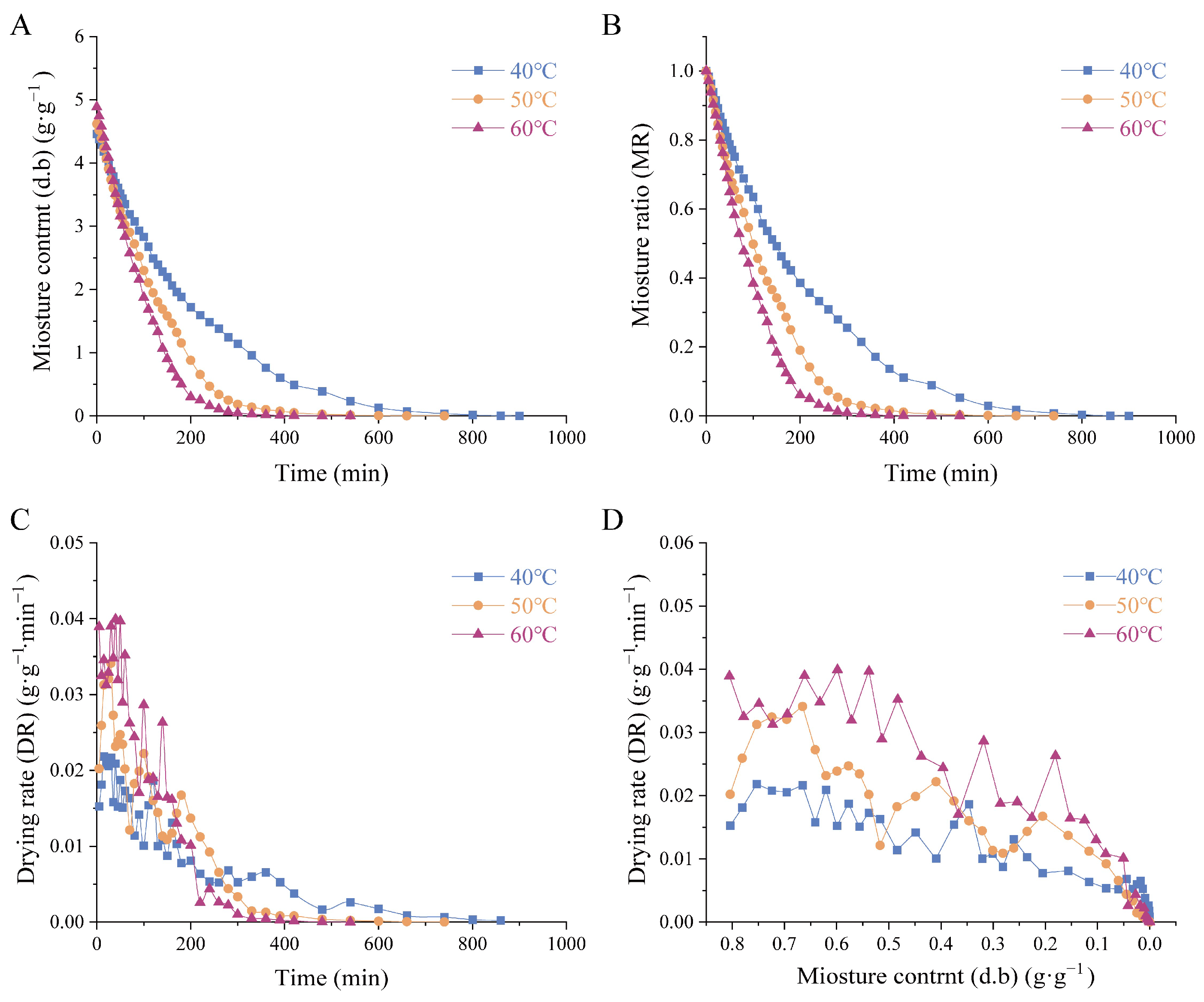
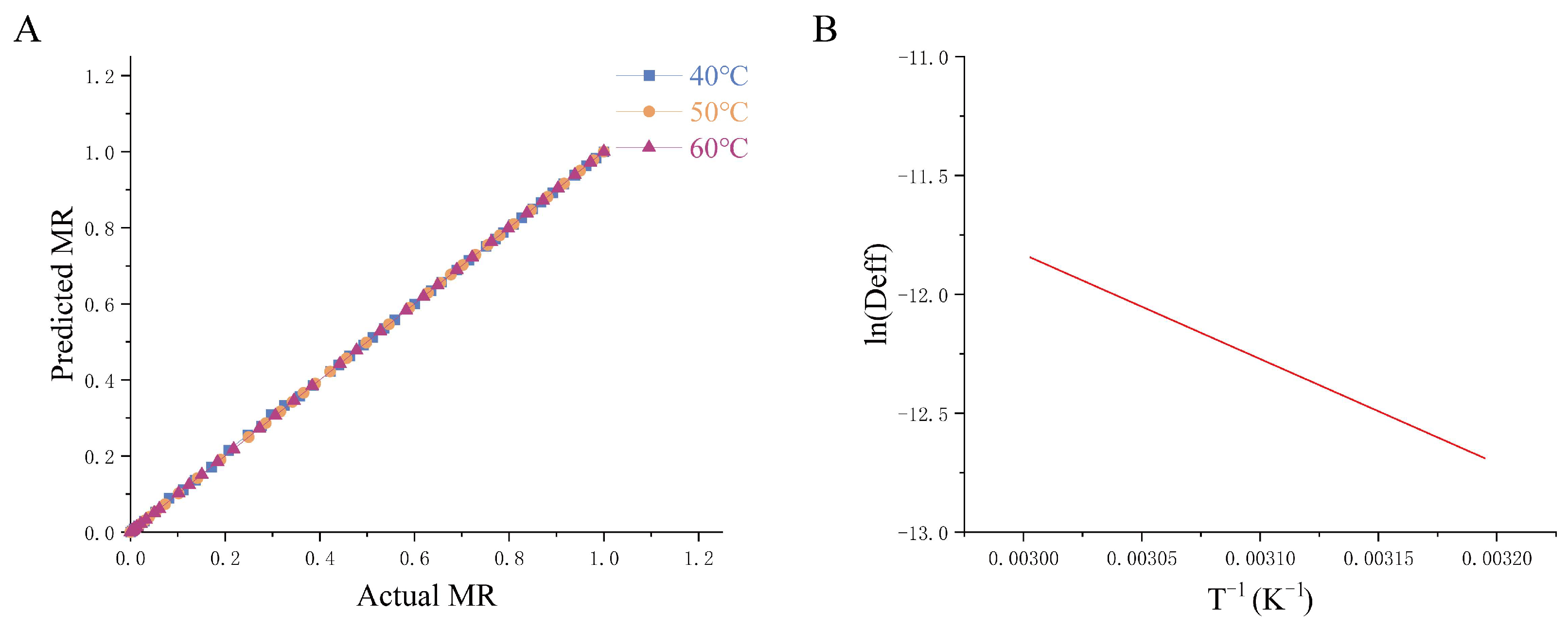
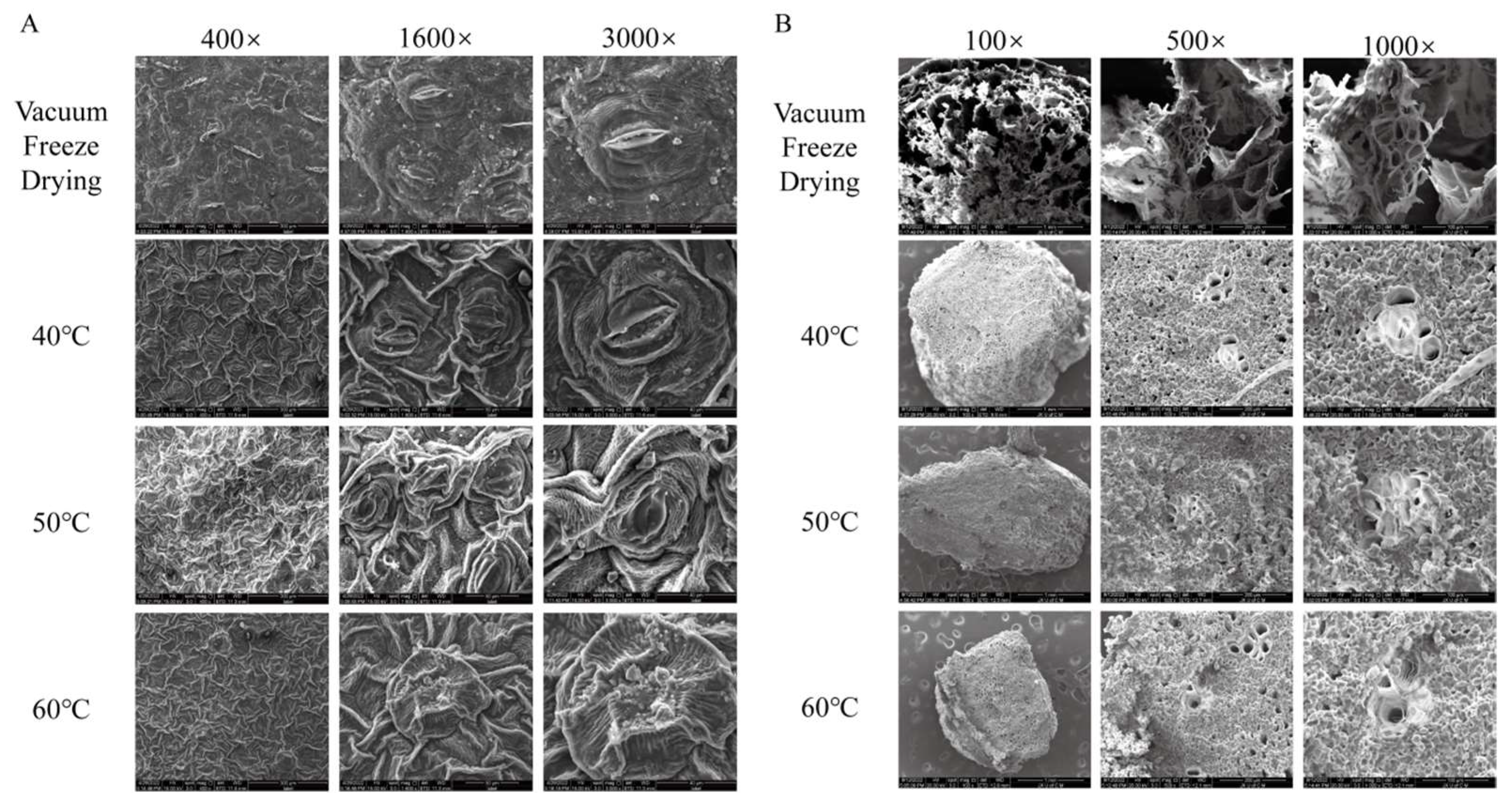
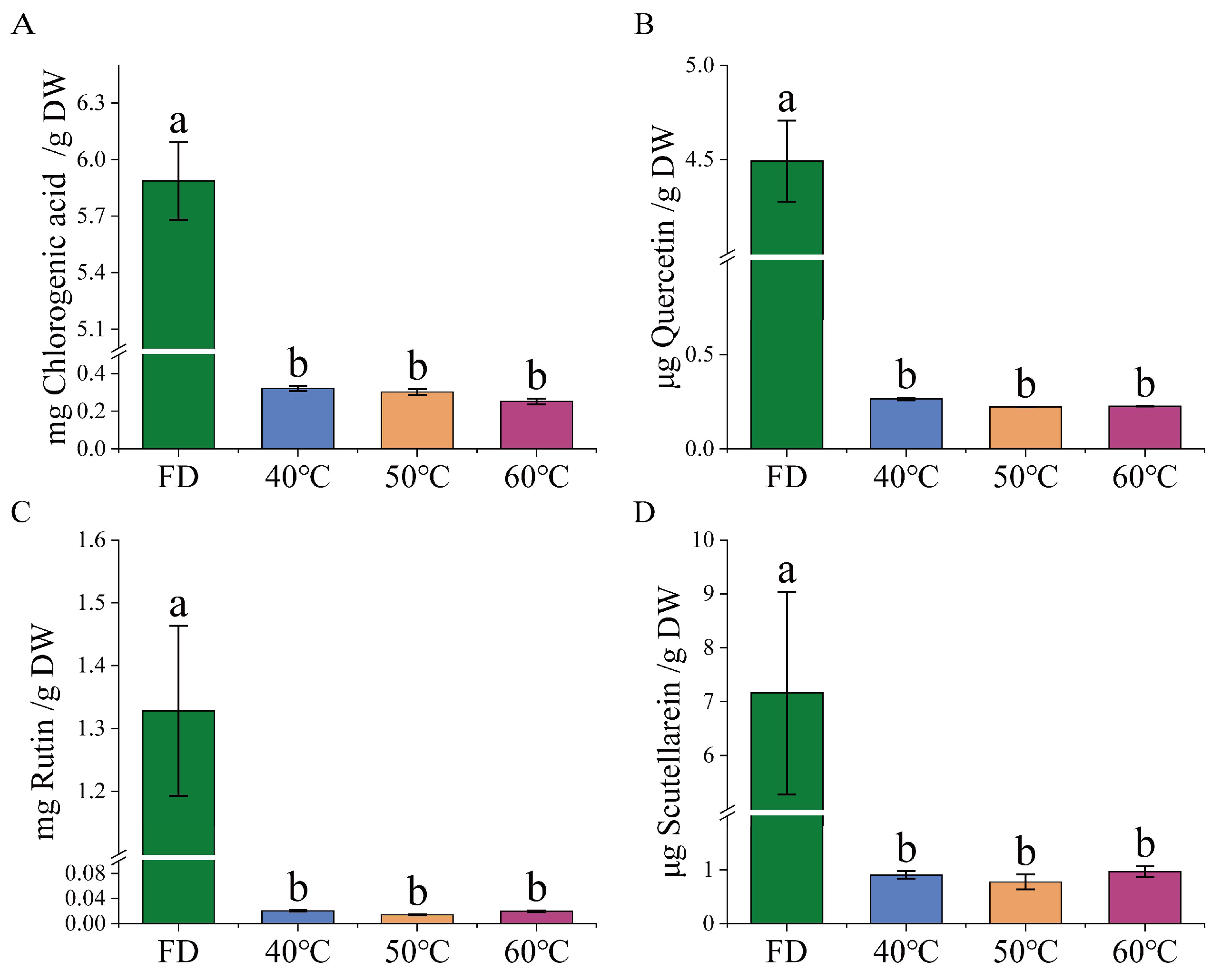
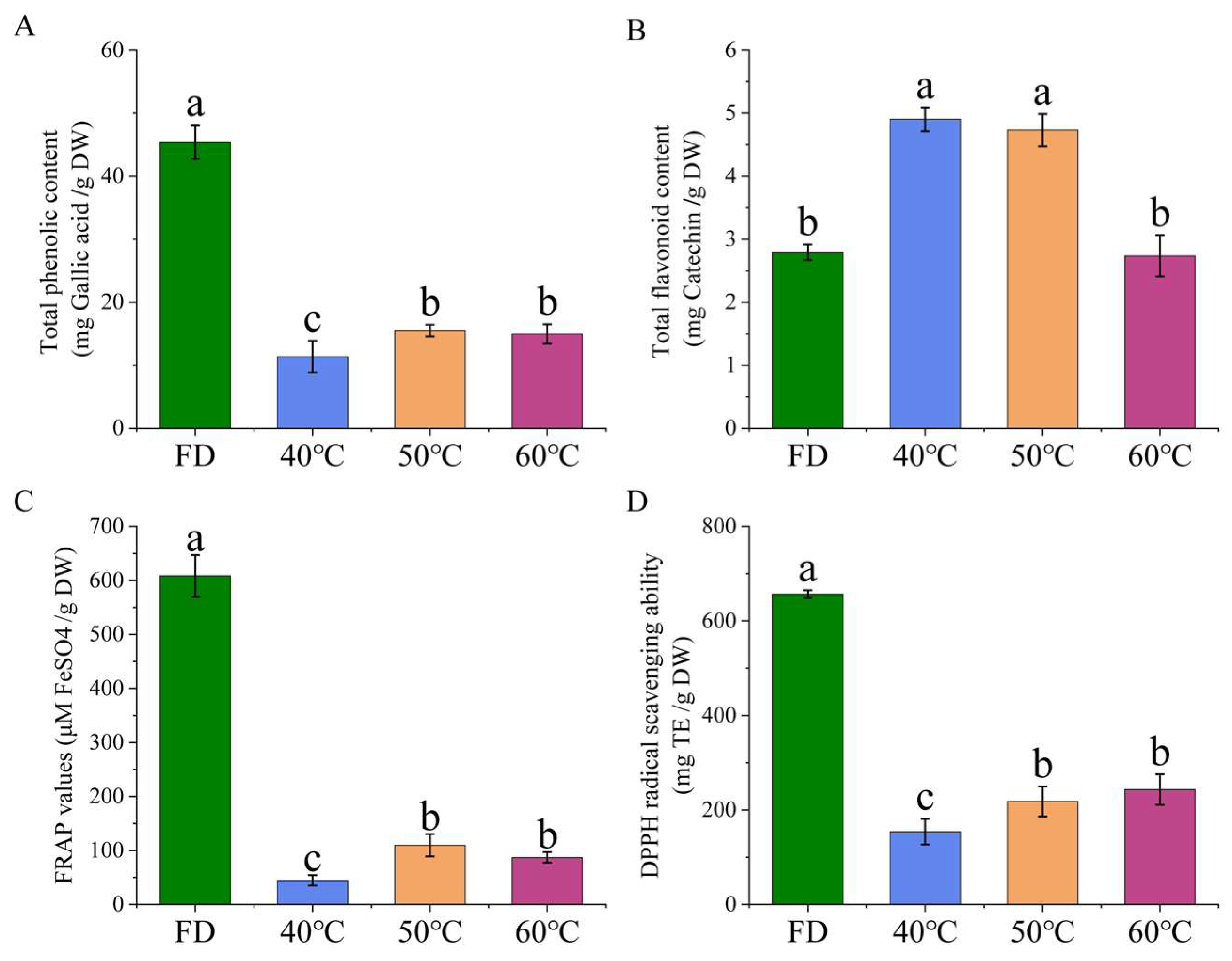
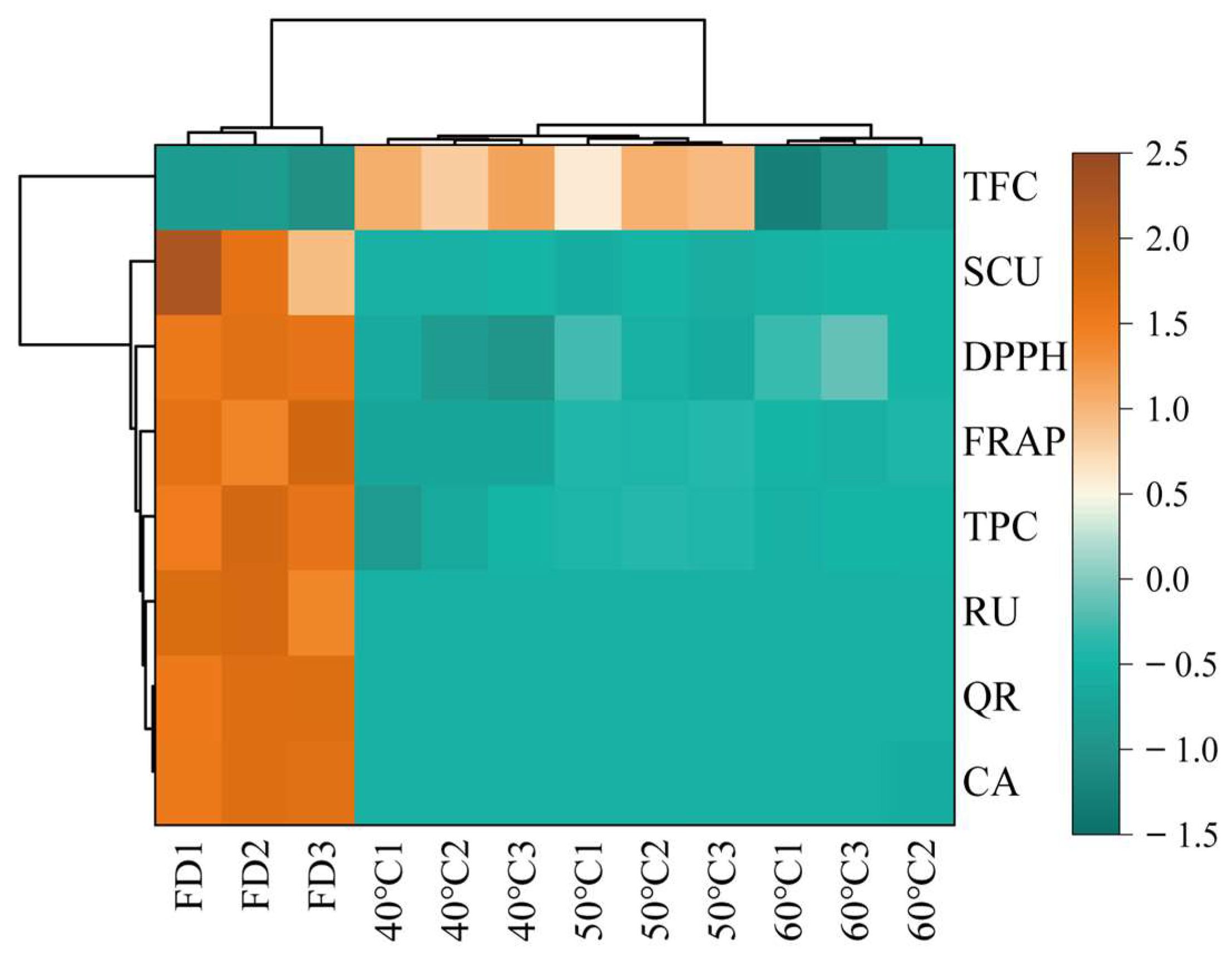


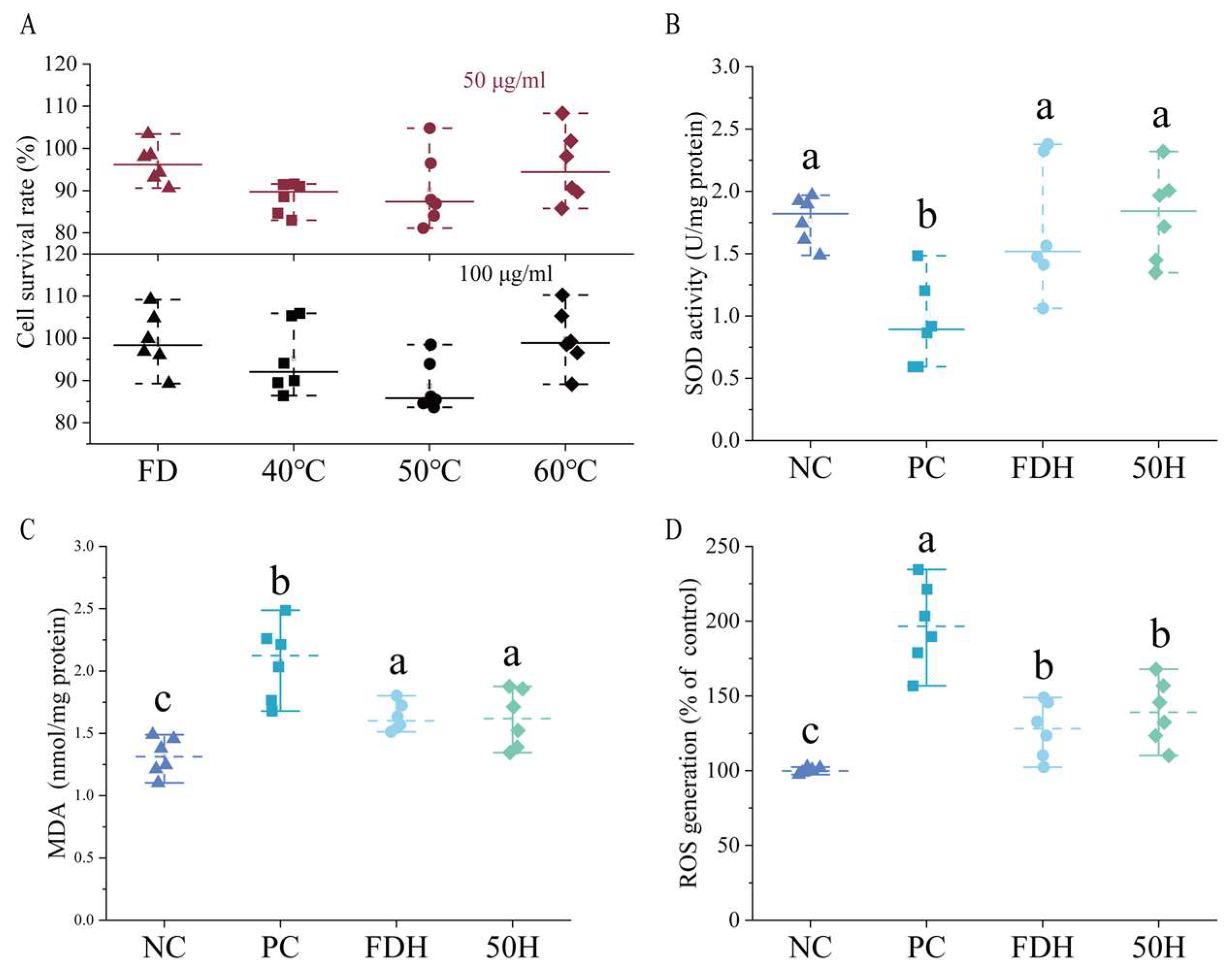
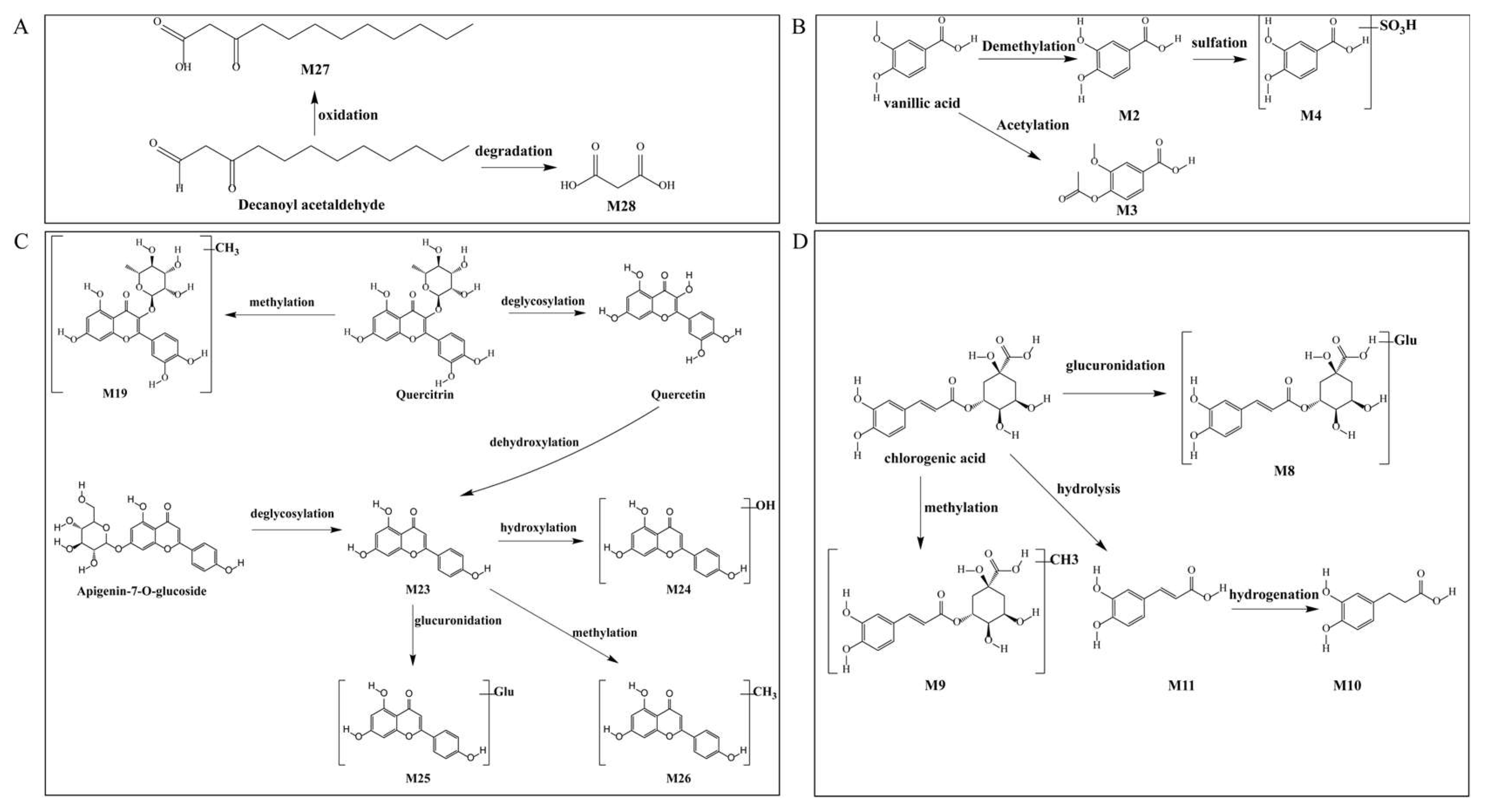

| Model NO. | Model Name | Model Equation | References |
|---|---|---|---|
| 1 | Lewis/Newton | [19] | |
| 2 | Page | [20] | |
| 3 | Henderson/Pabis | [21] | |
| 4 | Two-term | [22] | |
| 5 | Two-term Exponential | [23] | |
| 6 | Logarithmic | [24] | |
| 7 | Midilli | [25] | |
| 8 | Aghabashlo | [26] | |
| 9 | Wang and Singh | [27] | |
| 10 | Silva | [28] |
| Peak | tR (min) | Formula | [M − H]− (m/z) | Fragments (MS2) | FD | 40 °C | 50 °C | 60 °C | Tentative Identification |
|---|---|---|---|---|---|---|---|---|---|
| 1 | 1.11 | C4H6O5 | 133.01 | 115.19, 71.07 | + | + | + | + | malic acid |
| 2 | 1.12 | C6H8O7 | 191.02 | 111.04 | + | + | + | — | vanillic acid |
| 3 | 2.02 | C8H8O4 | 167.04 | 149.13, 123.06 | + | + | + | + | n6-succinyl adenosine |
| 4 | 2.15 | C14H17N5O8 | 382.10 | 206.10, 162.105, 134.04 | — | + | + | + | vannilic acid-4-o-β-l-rhamnoside |
| 5 | 2.76 | C14H18O8 | 313.09 | 167.27, 123.14, 121.24 | + | + | + | + | 5-(β-d-glucopyranosyloxy)-2-hydroxybenzoic acid |
| 6 | 2.95 | C13H16O9 | 315.11 | 153.07 | + | + | + | + | quinic acid |
| 7 | 3.06 | C7H12O6 | 191.06 | 173.23, 171.04, 127.00, 111.05 | + | + | + | + | isovanillin |
| 8 | 3.30 | C8H8O3 | 151.04 | 91.30 | + | + | + | + | chlorogenic acid |
| 9 | 3.51 | C16H18O9 | 353.09 | 191.08, 179.06, 135.04 | + | + | + | + | caffeic acid-O-hexoside |
| 10 | 5.46 | C15H18O9 | 341.09 | 179.06, 135.04 | + | + | — | + | methyl 4-acetoxy-3-hydroxybutanoate |
| 11 | 5.32 | C7H12O5 | 175.06 | 115.04, 85.15 | + | + | + | + | kaempferol-3-rutinoside |
| 12 | 7.40 | C27H30O15 | 593.15 | 285.01 | — | + | + | + | 5-acetamido-2-(2-carboxyethyl) benzoic acid |
| 13 | 9.69 | C12H13NO5 | 250.07 | 206.07, 164.93 | + | — | + | — | Houttuynoid A |
| 14 | 9.82 | C33H38O13 | 641.17 | 479.17, 461.32 | — | + | — | — | 5-O-p-Coumaroylquinic acid |
| 15 | 9.96 | C16H18O8 | 337.18 | 191.08 | + | + | + | — | 3,4-Dihydroxybenzoic acid |
| 16 | 10.25 | C7H6O4 | 153.02 | 109.22, 91.34 | + | + | — | — | rutin |
| 17 | 11.72 | C27H30O16 | 609.15 | 300.97, 271.05 | + | + | + | + | hispidulin-O-hexoside |
| 18 | 12.05 | C22H22O11 | 461.07 | 299.06, 283.06 | + | + | + | + | quercetin-O-hexoside |
| 19 | 12.29 | C21H20O12 | 463.09 | 301.06, 300.06 | + | + | + | + | 7-O-methylmangiferin |
| 20 | 12.68 | C20H20O11 | 435.09 | 315.10 | + | + | + | + | kaempferol-O-coumaroylhexoside |
| 21 | 13.40 | C30H26O13 | 593.15 | 447.20, 285.08, 255.12 | + | + | + | — | quercitrin |
| 22 | 14.25 | C21H20O11 | 447.09 | 401.26, 301.11, 271.29 | + | + | + | + | isorhamnetin-3-glucopyranoside |
| 23 | 14.57 | C22H22O12 | 477.11 | 315.03 | + | + | — | — | apigenin-7-O-glucoside |
| 24 | 16.37 | C21H20O10 | 431.10 | 285.08 | + | + | + | — | scutellarein |
| 25 | 16.75 | C15H10O6 | 285.04 | 151.19 | + | + | + | + | quercetin |
| 26 | 19.87 | C15H10O7 | 301.04 | 178.98, 151.04 | + | + | + | + | ouercetol |
| 27 | 20.04 | C15H10O7 | 301.04 | 273.15, 151.03 | — | + | + | + | dihydroisoferulic acid-3-o-glucuronide |
| 28 | 20.53 | C16H20O10 | 371.11 | 191.09, 134.08 | + | + | — | — | decanoyl acetaldehyde |
| 29 | 28.78 | C12H22O2 | 197.81 | 179.13, 169.09, 154.06, 135.91 | + | + | + | + | 10-hydroxydecanoic |
| 30 | 29.55 | C10H20O3 | 187.13 | 141.10 | + | + | + | + | (6e,8z)-18-hydroxy-5-oxo-6,8-octadecadienoic acid or isomer |
| 31 | 28.61 | C18H30O4 | 309.21 | 291.26, 221.18 | — | + | + | + | decanoic acid |
| 32 | 29.16 | C18H28O4 | 307.19 | 235.15, 125.25 | — | + | + | + | 12,13,17-trihydroxyoctadec-9-enoic acid |
| 33 | 29.18 | C18H34O5 | 329.23 | 229.16, 211.27, 193.09, 171.08 | — | + | + | + | 10-hydroxydecanoic acid |
| 34 | 30.08 | C13H24O3 | 227.13 | 183.16 | — | + | — | — | l-menthyl lactate |
| 35 | 31.44 | C17H28O5 | 311.22 | 293.32 | — | + | + | + | arteether |
| 36 | 32.22 | C18H30O3 | 293.21 | 275.25, 223.12, 205.23 | — | + | + | + | 12-hydroxy-9-octadecenoic acid |
| 37 | 32.41 | C18H36O4 | 315.25 | 297.25, 171.26 | — | + | — | — | 9,12-dihydroxyoctadecanoic acid |
| Peak | tR (min) | Formula | [M − H]− (m/z) | Fragments (MS2) | Serum | Identification | Original Compounds | |
|---|---|---|---|---|---|---|---|---|
| 50H | FDH | |||||||
| M1 | 39.41 | C4H6O6 | 149.0107 | 74.9963, 59.9747 | — | + | Hydroxylation | malic acid |
| M2 | 4.31 | C7H6O4 | 153.0237 | 96.9634, 79.9619 | + | + | Demethylation | vanillic acid |
| M3 | 7.92 | C10H10O5 | 209.04566 | 165.056 | + | + | Acetylation | vanillic acid |
| M4 | 1.77 | C7H6O7S | 232.97405 | 160.8908 | + | + | Demethylation Sulfation | vanillic acid |
| M5 | 15.8 | C7H12O7 | 207.05201 | 162.8414 | — | + | Hydroxylation | Quinic acid |
| M6 | 1.14 | C8H8O4 | 167.02224 | 167.02224 | + | — | Hydroxylation | isovanillin |
| M7 | 3.8 | C14H16O9 | 327.0712 | 283.0752 | + | + | Glucuronidation | isovanillin |
| M8 | 30.44 | C22H26O15 | 529.11817 | 200.8584 | — | + | Glucuronidation | chlorogenic acid |
| M9 | 1.08 | C17H20O9 | 367.10454 | 307.0841, 157.0321 | + | — | Methylation | chlorogenic acid |
| M10 | 7.92 | C9H10O4 | 181.05145 | 136.0184, 93.0297 | + | + | Hydrolysis | chlorogenic acid |
| M11 | 9.75 | C9H8O4 | 179.03513 | 143.8653, 134.9881 | + | + | Hydrolysis | chlorogenic acid |
| M12 | 7.11 | C12H19O11 | 338.08691 | 162.0569 | + | + | Hydrolysis Glucuronidation | methyl 4-acetoxy-3-hydroxybutanoate |
| M13 | 2.13 | C4H8O3 | 103.0427 | 59.0217 | + | — | Hydrolysis | methyl 4-acetoxy-3-hydroxybutanoate |
| M14 | 8.21 | C10H11NO4 | 208.06233 | 165.0614, 87.9269 | + | + | Hydrolysis | 5-acetamido-2-(2-carboxyethyl) benzoic acid |
| M15 | 15.08 | C7H7NO3 | 152.03668 | 122.0381 | + | - | Hydrolysis | 5-acetamido-2-(2-carboxyethyl) benzoic acid |
| M16 | 9.54 | C9H8O3 | 163.04073 | 147.8876, 119.0519 | + | + | Hydrolysis | 5-O-p-Coumaroylquinic acid |
| M17 | 11.13 | C7H6O3 | 137.02574 | 93.0384 | + | + | Hydrolysis | 5-O-p-Coumaroylquinic acid |
| M18 | 15.83 | C16H12O6 | 299.05479 | 284.0314 | — | + | Hydrolysis | Hispidulin-O-hexoside |
| M19 | 15.56 | C22H22O11 | 461.10722 | 285.0726 | + | + | Methylation | Quercitrin |
| M20 | 12.49 | C21H22O11 | 449.10576 | 273.0743 | + | + | Methylation | 7-O-methylmangiferin |
| M21 | 13.88 | C22H19O15 | 522.07036 | 431.0637, 332.9840 | — | + | Hydroxylation | isorhamnetin-3-glucopyranoside |
| M22 | 17.41 | C23H24O12 | 491.11772 | 401.08 | — | + | Methylation | isorhamnetin-3-glucopyranoside |
| M23 | 15.32 | C15H10O5 | 269.04461 | 269.0444 | — | + | Hydrolysis | Apigenin-7-O-glucoside |
| M24 | 13.49 | C15H10O6 | 285.03853 | 202.8602, 150.9995, 133.0314 | — | + | Hydrolysis, Hydroxylation | Apigenin-7-O-glucoside |
| M25 | 9.61 | C21H18O11 | 445.07596 | 269.0446 | + | + | Hydrolysis Glucuronidation | Apigenin-7-O-glucoside |
| M26 | 2.58 | C16H12O5 | 283.06769 | 151.0272 | + | + | Hydrolysis, Methylation | Apigenin-7-O-glucoside |
| M27 | 20.73 | C12H22O3 | 213.14978 | 59.0198 | + | + | Hydroxylation | decanoyl acetaldehyde |
| M28 | 1.2 | C3H4O4 | 103.00603 | 59.0218 | + | - | Hydrolysis | decanoyl acetaldehyde |
| M29 | 13.65 | C10H18O4 | 201.1137 | 183.1047, 138.1147 | + | + | Hydroxylation | 10-hydroxydecanoic |
| M30 | 27.6 | C18H30O5 | 325.18368 | 183.0123 | + | — | Hydroxylation | (6e,8z)-18-hydroxy-5-oxo-6,8-octadecadienoic acid |
| M31 | 19.59 | C25H38O10 | 497.23737 | 321.206 | + | — | Hydroxylation Glucuronidation | (6e,8z)-18-hydroxy-5-oxo-6,8-octadecadienoic acid |
| M32 | 6.55 | C20H35O6N | 366.23453 | 304.2383 | + | — | Glycine binding | (6e,8z)-18-hydroxy-5-oxo-6,8-octadecadienoic acid |
| M33 | 2.94 | C9H10O5 | 197.04889 | 162.8403 | + | — | Hydrolysis | arteether |
| M34 | 20.97 | C18H28O4 | 307.19112 | 289.1816, 191.1061 | + | — | Hydroxylation | 12-hydroxy-9-octadecenoic acid |
| M35 | 16.95 | C18H32O5 | 327.2164 | 171.0989 | + | + | Hydroxylation | 12-hydroxy-9-octadecenoic acid |
| M36 | 30.4 | C18H32O2 | 279.23254 | 279.2324 | + | + | Hydrolysis | 12-hydroxy-9-octadecenoic acid |
| M37 | 28.38 | C18H30O2 | 277.21662 | 165.0575 | + | + | Restore | 12-hydroxy-9-octadecenoic acid |
| M38 | 22.57 | C24H44O10 | 491.28011 | 491.2839 | + | — | Glucuronidation | 9,12-dihydroxyoctadecanoic acid |
| M39 | 20.32 | C19H38O4 | 329.26843 | 329.2694 | + | + | Methylation | 9,12-dihydroxyoctadecanoic acid |
| M40 | 22.12 | C18H34O4 | 313.23795 | 201.1134 | + | + | Hydroxylation | 9,12-dihydroxyoctadecanoic acid |
| Compound | T1/2 (h) | Tmax (h) | Cmax (nM) | AUC (h × nM) | |
|---|---|---|---|---|---|
| Rutin | 50H | 2.04 ± 0.50 | 1.0 | 124.55 ± 4.95 | 277.12 ± 12.26 |
| FDH | 2.61 ± 1.23 | 1.0 | 135.77 ± 16.02 | 328.20 ± 5.68 | |
| Quercetin | 50H | 7.28 ± 4.47 | 2.0 | 377.93 ± 21.44 | 2320.45 ± 57.37 |
| FDH | 4.46 ± 0.14 | 2.0 | 410.07 ± 12.00 | 2550.76 ± 17.03 | |
| Chlorogenic acid | 50H | 2.05 ± 0.62 | 1.5 | 84.39 ± 2.26 | 221.69 ± 22.46 |
| FDH | 2.25 ± 0.70 | 1.5 | 103.56 ± 9.47 | 231.19 ± 7.87 | |
| Scutellarin | 50H | 9.26 ± 4.35 | 1.5 | 22.03 ± 4.15 | 120.56 ± 4.62 |
| FDH | 6.91 ± 0.65 | 1.5 | 23.92 ± 3.17 | 115.99 ± 7.02 |
Disclaimer/Publisher’s Note: The statements, opinions and data contained in all publications are solely those of the individual author(s) and contributor(s) and not of MDPI and/or the editor(s). MDPI and/or the editor(s) disclaim responsibility for any injury to people or property resulting from any ideas, methods, instructions or products referred to in the content. |
© 2025 by the authors. Licensee MDPI, Basel, Switzerland. This article is an open access article distributed under the terms and conditions of the Creative Commons Attribution (CC BY) license (https://creativecommons.org/licenses/by/4.0/).
Share and Cite
Yin, N.; Luo, J.; Wang, C.; Xiong, Y.; Sun, Y.; Yuan, E.; Zhang, H. Comprehensive Evaluation of the Effects of Hot Air Drying Temperature on the Chemical Composition, Flavor Characteristics and Biological Activity of Houttuynia cordata Thunb. Foods 2025, 14, 1962. https://doi.org/10.3390/foods14111962
Yin N, Luo J, Wang C, Xiong Y, Sun Y, Yuan E, Zhang H. Comprehensive Evaluation of the Effects of Hot Air Drying Temperature on the Chemical Composition, Flavor Characteristics and Biological Activity of Houttuynia cordata Thunb. Foods. 2025; 14(11):1962. https://doi.org/10.3390/foods14111962
Chicago/Turabian StyleYin, Ning, Jing Luo, Chaoping Wang, Yaokun Xiong, Yong Sun, En Yuan, and Hua Zhang. 2025. "Comprehensive Evaluation of the Effects of Hot Air Drying Temperature on the Chemical Composition, Flavor Characteristics and Biological Activity of Houttuynia cordata Thunb." Foods 14, no. 11: 1962. https://doi.org/10.3390/foods14111962
APA StyleYin, N., Luo, J., Wang, C., Xiong, Y., Sun, Y., Yuan, E., & Zhang, H. (2025). Comprehensive Evaluation of the Effects of Hot Air Drying Temperature on the Chemical Composition, Flavor Characteristics and Biological Activity of Houttuynia cordata Thunb. Foods, 14(11), 1962. https://doi.org/10.3390/foods14111962






